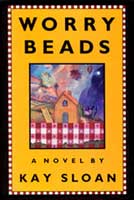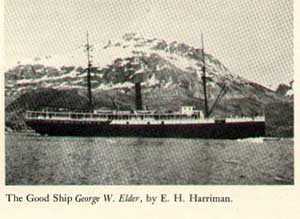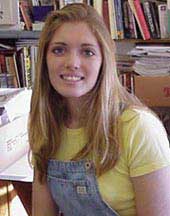Major Works
- We Were Not All Bigots (to be published) memoir
- Give Me You, (2015), novella in process of publication
- Not Without Honor: The Nazi POW Journal of Steve Carano, editor (2008), historical work
- The Birds Are on Fire (New Women’s Voices Series, No. 31) (2006), poetry
- The Patron Saint of Red Chevys (2004) novel
- Elvis Rising: Stories of the King, co-editor with Constance Pierce, (1993), short stories
- Worry Beads (1991) novel
- The Loud Silents: Origins of Social Problems (1988) historical work
- Looking Far North: The Harriman Expedition to Alaska, 1899 with William Goetzmann, (1982) historical work
Kay Sloan: A Biography
by Shanna Holder (SHS) 2000
Kay Sloan was born in Hattiesburg, Mississippi, on April 11, 1951. She is the daughter of Andrew G. and La Verne David Sloan. Her family moved to Biloxi, Mississippi, and then later they moved to Jackson. There in Jackson, Sloan attended Wingfield High School and graduated in 1969. She was secretary of the student body and on the student council. After high school, Sloan went to Millsaps College in Jackson. She was only there for two years before she transferred to the University of California in Santa Cruz. There she received a bachelor’s degree in sociology. Although her true love was in literature and history, it wasn’t until she moved to the University of Texas in Austin that she finally got to study them in graduate school. She received both a master’s and a doctor’s degree (Sloan interview). Afterwards, Sloan worked in the Institute for Policy Studies in Washington, D.C., as a research associate from 1977-1978 (May 460). In 1979, the University of Texas offered her a job as an instructor in American studies (May 460). Sloan worked there until 1984 when she accepted a job at the Miami University in Oxford, Ohio, as an English professor (Hamrick). She has been at Miami University of Ohio ever since, teaching courses on Southern writers, creative writing, and American Studies.
Besides having an extensive work life, Kay Sloan also has a happy personal life. During her marriage to the poet David Schloss, Kay became the proud mother of her daughter, Signe Schloss. Signe is also a published author because at the age of three she wrote Pictures in the Mud, which was released in the children’s corner section of the Louisville Review. Signe seems to be following in her mother’s footsteps (Sloan interview).
 Sloan has written a novella, two novels, a book of poetry, and several books on cultural history. Her first book, Looking Far North: The Harriman Expedition to Alaska, 1899, which is non-fiction, was co-written with Willaim H. Goetzmann. While in graduate school, she also wrote a documentary with Pulitzer Prize winning author, William H. Goetzmann, based on the book. It is about a wealthy railroad owner’s prospects on America’s last frontier. The second non-fiction book Sloan wrote was The Loud Silents: Origins of the Social Problem. This book is about silent movies. Patrick G. Gerster of the Journal of American History states that The Loud Silents: Origins of the Social Problem is “an excellent book and is further evidence that film study is continuing to find a respected place with in a culture that by habitat most always has privileged the written word” (Hamrick). Sloan’s next book was her first novel and was inspired by memories from her experiences while living in Mississippi called Worry Beads, published in 1991 while she was living in Ohio. In 1992 Worry Beads won the Ohioana Prize for fiction.
Sloan has written a novella, two novels, a book of poetry, and several books on cultural history. Her first book, Looking Far North: The Harriman Expedition to Alaska, 1899, which is non-fiction, was co-written with Willaim H. Goetzmann. While in graduate school, she also wrote a documentary with Pulitzer Prize winning author, William H. Goetzmann, based on the book. It is about a wealthy railroad owner’s prospects on America’s last frontier. The second non-fiction book Sloan wrote was The Loud Silents: Origins of the Social Problem. This book is about silent movies. Patrick G. Gerster of the Journal of American History states that The Loud Silents: Origins of the Social Problem is “an excellent book and is further evidence that film study is continuing to find a respected place with in a culture that by habitat most always has privileged the written word” (Hamrick). Sloan’s next book was her first novel and was inspired by memories from her experiences while living in Mississippi called Worry Beads, published in 1991 while she was living in Ohio. In 1992 Worry Beads won the Ohioana Prize for fiction.
In 2014 Sloan won the Faulkner Pirates Alley Novella Award for Give Me You, which, according to the Judge Moira Crone, is an “exploration of the lives of four members of the greatest generation who …are …willing to reveal their sins, furies, and many detours from greatness…and becomes an evocation of how time adjusts all wounds….” The novella is in the process of being published. Sloan also co-edited a collection of short stories with Constance Pierce about Mississippian Elvis Presley entitled Elvis Rising. Mississippi also inspired Sloan’s second novel, The Patron Saint of Red Chevys, published in 2004.
Dr. Sloan doesn’t just write non-fiction books and novels but also poems and short stories. In fact, her first publication was a poem, The First Glaciers, which was published in Southern Exposure. Sloan was nominated for the Pushcart Prize in 1981 for this poem (May 461). She has contributed short stories, essays, and poetry to the Texas Observer, the American Quarterly, and the Paris Review. Some of her short stories are about her travels and adventures in Greece, Belgium, then-Czechoslovakia and Russia.
Her historical book Looking Far North: The Harriman Expedition to Alaska, 1899 became, almost twenty years after its publication, the source of a PBS documentary on the expedition. The trip was re-created in Alaska and was called The Harriman Expedition Recreated. Kay Sloan worked with the producers and cameramen for a week and got to see some of the sights that the original crew members saw. The show aired in the fall of 2001.
Kay Sloan has led a fulfilling life. She has been writing stories ever since elementary school and has always wanted to be a writer. She is the epitome of writing success, not only because she has published much of her writing, but also because she believes in herself and in each of her pieces. She also embraces her Mississippi heritage, sharing her stories of Mississippi through her poems, short stories, and novels. Her current work-in-progress is a memoir entitled We Were Not All Bigots, about her growing up in Mississippi during the Civil Rights era in the 1960’s.
Reviews
A Review of Looking Far North: The Harriman Expedition to Alaska, 1899
by Shanna Holder (SHS)

The Good Ship George W. Elder, by William Harriman
(picture from Edward Curtis collection at the University of Texas archives)
This book, edited by William H. Goetzmann and Kay Sloan, is a detailed account of the William Harriman expedition to Alaska. Harriman was the wealthy Union Pacific Railroad president. He quit school at the age of fourteen and began to work in the stock market.
In 1889, Harriman took twenty-two scientists, his family, and personal physician on the trip. It was supposed to be a vacation for Harriman because of his failing health. However, Harriman had another reason for going to Alaska. He wanted to build a railroad all around the world, and he was going to start by building a bridge over the Bering Strait and through Canada into the United States. He took the scientists on his excursion because Harriman wanted to learn more about the Klondike. The explorers took a train to get to Seattle where the ship, the George Elder, was waiting to take them to Alaska.
The book is extremely well written and gives a significant amount of information, which must have taken months to gather. Some of the information is taken from journals of the scientists themselves. The photographs by Edward S. Curtis involve the reader more thoroughly in these adventures of Alaska.
I enjoyed reading this book, although it was hard to follow because of the many people involved. I liked the personal accounts from the scientists. They make the book more like a novel rather than a documentary. I thought Harriman’s vivid details of the picturesque scenery, edited by Sloan and Goetzmann was especially interesting.
E-mail Interview with Kay Sloan (2000)
by Shanna Holder (SHS)
Where did you go to high school? Where did you go to college? What did you major in?
In Jackson, I went to Wingfield High School, graduating in 1969, and then Millsaps College. As a junior, I transferred to the University of California at Santa Cruz and majored in sociology. The University of Texas is where I got an M.A. and Ph.D.
We were studying the civil rights movement, and I was wondering whether your school was integrated while you were there.
No, my school was all white when I graduated in 1969, and there was a great deal of racism at that school. I even remember that one of the coaches would give the boys “licks” with a paddle if they weren’t for George Wallace for President in 1968! It was an appalling environment, and one that I was eager to escape. I went to Millsaps in 1969, and, of course, the killings at Jackson State happened in May of 1970, when I was a freshman. I participated in the marches afterward, and visited the campus, sitting with other students, both African American and white, in front of the women’s dormitory that had been shot up by the Highway Patrol. So that’s a little bit of what Mississippi was like in the 1960s. It always finds its way into my fiction or essays.
Did you receive any honors or awards in high school such as most likely to succeed or best writer?
At Wingfield High School, I was on the student council, secretary of the student body, and a pretty good student. As far as honors, they had a category in the Who’s Who, which was “Most Feminine” and “Most Masculine.” I was “Most Feminine” for three years! (But what does that mean?) And my senior year, I was also voted “Most Sincere.” At my 10th high school reunion, though, I was given the “Most Interesting Life” award, because, as the M.C. said, “We can’t figure out what she’s doing.”
It seems like you have had a very successful career, what do you think is the most successful thing you have ever done?
The most successful thing I’ve done is a difficult question! There are so many kinds of successes: being a good mother, a challenging teacher, a good writer. But, at this point, I feel that the novel I’ve just written, The Patron Saint of Red Chevys, is probably the most successful thing I’ve written, in that the themes weave together in a way that surprised me, and the characters feel very alive to me. Next year, I’d probably have a very different answer.
Are you married or do you have any children?
Yes, I am married, to a poet, David Schloss (for eleven years), who also teaches creative writing at Miami University (this is in Oxford, Ohio — the one in Miami, Florida is University of Miami). We have a daughter, Signe Schloss, who is six years old and in kindergarten. Signe is also a published author, having written a story called “Pictures in the Mud” when she was three. A colleague of mine suggested I send it to Louisville Review, which has a children’s corner, and it was published soon after.
Why did you decide to move to Ohio?
I moved to Ohio because Miami University offered me a job teaching American Studies — and there are very few jobs in American Studies! So here I am in the Mid-west, a place I never expected to wind up in.
Did you experience a culture shock from all the other places you’ve lived?
I DID experience culture shock when I moved from Mississippi to California at age nineteen. Everything was very different, it even seemed as if people had shorter memories in the west. And my Southern accent was seen (heard) as very strange, to the point that people heard the accent more than what I had to say, in class. Since then, though, I have felt pretty much at home where I go.
The big exception to this are my travels behind the “Iron Curtain” before the fall of Communism in East Germany and Czechoslovakia in 1988. It was impossible to feel “at home,” like going through a mirror and finding everything in reverse. In 1991, my husband and I were in Moscow when the attempted overthrow of Gorbechov occurred, and I wrote a photo essay of our experiences in our three days there. A fascinating experience, and probably the most exciting thing that’s ever happened to me. We heard Yeltsin speak from the Russian Parliament, saw the tanks grinding up the streets, saw the people crying. It was only after leaving that we learned the hard-line Communists had been defeated.
What was your life like in Mississippi? Did you enjoy it? Do you have any interesting stories?
In elementary school, I would look forward to summer vacations as a time when I could write what I called my “novels.”
Has Mississippi inspired any of your writing?
I majored in sociology – mainly because I was interested in the kinds of social change that happened in Mississippi as I was growing up in the 1960’s.
Who is you favorite author?
My favorite authors are Southern writers, Faulkner and Welty come to mind, in particular.
What was you favorite subject in school and why?
Though I majored in sociology, my favorite courses were in literature and history, which is what I studied in graduate school in the American Studies Program at the University of Texas
When did you become interested in writing?
Somehow, I can’t remember a time when I didn’t want to be writer.
What inspired you to write Looking Far North?
Looking Far North: The Harriman Expedition to Alaska, 1899.It was inspired by the discovery that the Edward Curtis photographs from the expedition were held in an archive on the University of Texas campus. You’ll probably be interested in knowing that this book is now, almost twenty years after publication, the source of a PBS documentary on the expedition. It’s called The Harriman Expedition Recreated, and the trip will be re-created in Alaska this summer. I’ll be on board for a week, and I’ll get to see some of the sights that the original members saw. So that’s exciting. It should air in the fall of 2001.
Have you received any awards for your writings?
My favorite book is my novel, Worry Beads, which came out in 1991 and won the Ohioana Prize for Fiction in 1992. It’s set in Mississippi, and I was able to use some of the memories I had from growing up in the South as a springboard for my characters.
What other type things have you written?
Though I’ve written another non-fiction book, on silent movies (The Loud Silents: Origins of the Social Problem), I also co-edited a book of short stories about Elvis, called Elvis Rising, which came out in 1993.
Where else have you lived besides Hattiesburg? What have you been doing since you moved away?
Though I’ve lived in Cincinnati, Ohio, for sixteen years, I still haven’t written anything set here; my stories, novels, and poetry are inspired by Mississippi, California, and the two places in Europe where I’ve lived, Belgium and Greece. But Mississippi remains the most important source of my work.
Do you have any advice for future writers or students?
My advice for future writers is perseverance write because you love to, because you have something to say, and learn how to deal with disappointment. The greatest rewards from writing aren’t from publishing, they come from that moment of knowing that what you’ve written is good.
Are you currently working on a new book? What is it called? When will it be published?
I’ve just finished a second novel, The Patron Saint of Red Chevys, now with my agent, and it, too, was very much inspired by Mississippi, especially the Gulf Coast. I’ve no idea when it’ll be published.
Have you published anything in newspapers or magazines?
My short stories, essays, and poetry have been published in such journals as Paris Review, Southern Review, Southern Exposure, etc.
You have a long list of achievements. What are you going to take on next?
Next year, I’ll be teaching a course on Southern writers at Miami University, a chance to re-read some of my favorite authors!
Related Websites
- Kay Sloan’s website
- Miami University page for Kay Sloan
- 2014 William Faulkner–William Wisdom Creative Writing Competition Winners
- Kay Sloan’s LinkedIn profile
- Interview with Kay Sloan by Pam Kingsbury
Bibliography
- Hamrick, Catherine. “Kay Sloan-Mississippi on her Mind, “Women in Publishing, Millsaps Magazine Spring-Summer. [online]http://www.millsaps.edu/pubel/magazine/Fall99/story5c.html, 7 April 2000.
- Hamrick, Catherine. Women in Publishing, Millsaps Magazine Spring-Summer 1999.[online] http://www.millasaps.edu/pubrel/magazine/Fall99/story5.html, 7 April 2000
- May, Hal, ed. “Kay Sloan.” Contemporary Authors. Vol 108. Detroit: Gale, 1983. 460-451.
- Sloan Kay, ed. Elvis Rising: Stories of the King. New York City: Avon, 1993
- Sloan, Kay, and Goetzmann, William H. Looking Far North: the Harriman Expedition to Alaska, 1899. New York: The Viking Press, 1982.
- Sloan, Kay. The Loud Silents: Origins of Social Problems. Urbana: University of Illinois Press, 1988.
- Sloan, Kay. Re: Mississippi Writer Research Project. [online] Available email: [email protected], 28 April 2000.
- Sloan, Kay. Re: Thanks. [online] Available email: [email protected], 1ma


